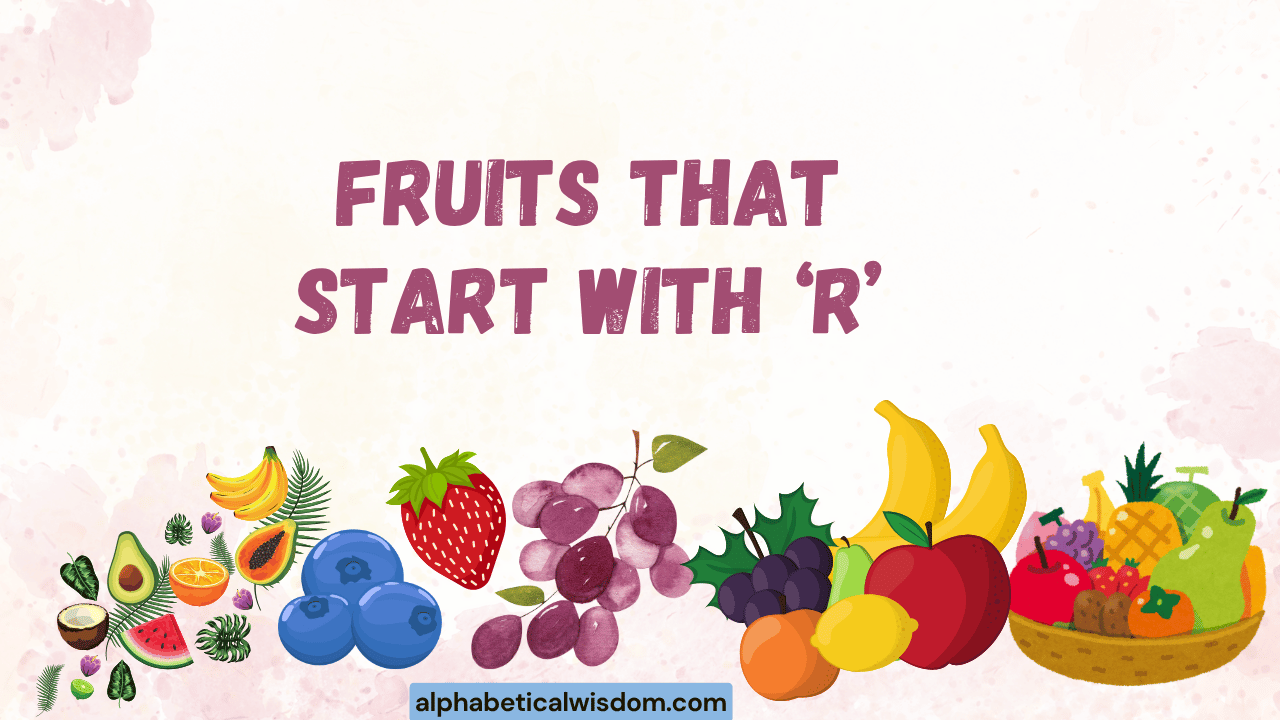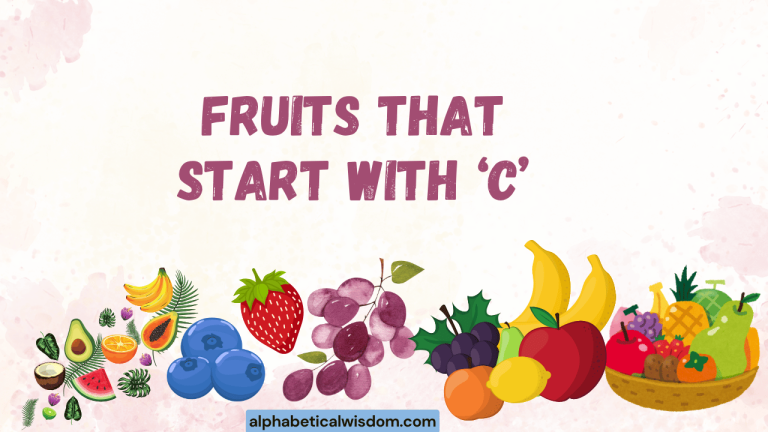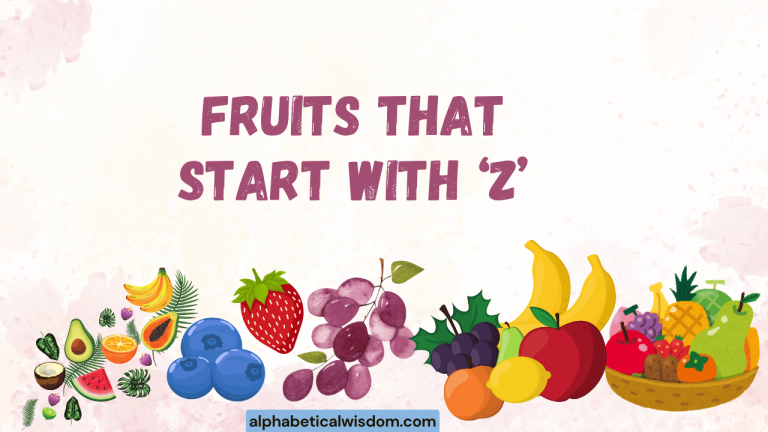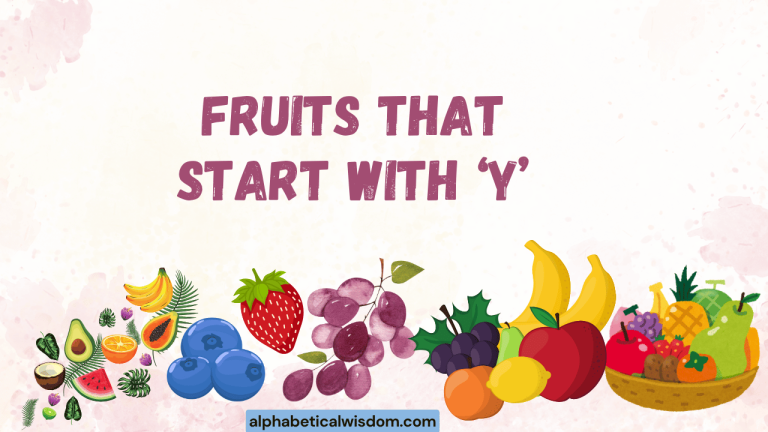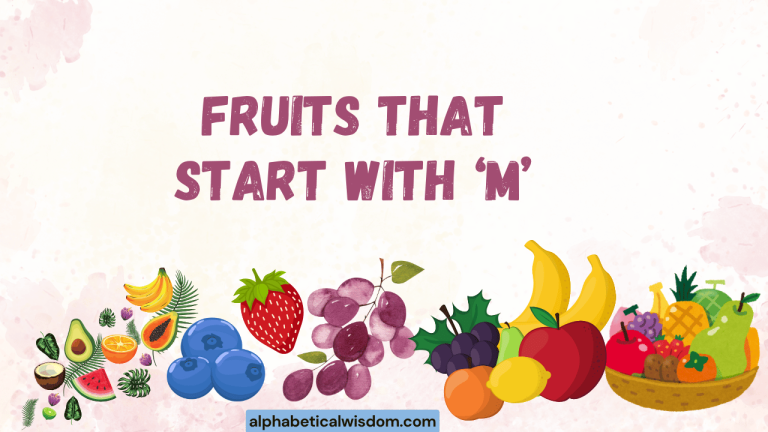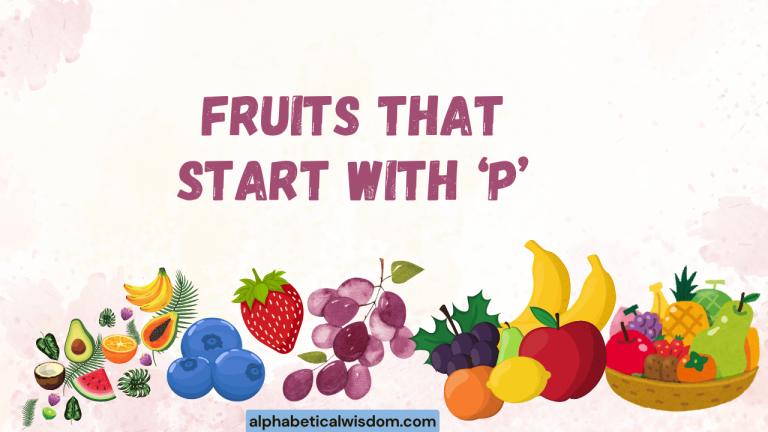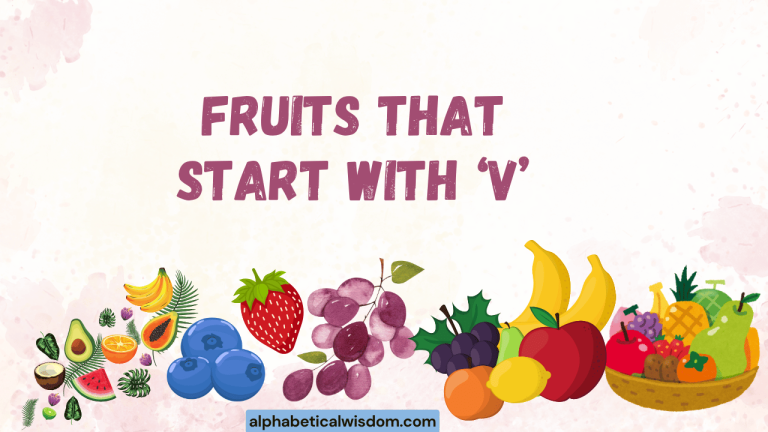Fruits That Start With R: A Grammatical Exploration
Exploring the English language involves more than just understanding complex sentence structures and verb conjugations. It also includes expanding our vocabulary and appreciating the nuances of everyday words.
This article focuses on fruits that start with the letter “R,” examining their grammatical roles and how they function within sentences. Understanding these nouns, their plurals, and their usage in various contexts can enhance your communication skills and deepen your appreciation for the English language.
This guide is perfect for English language learners, educators, and anyone interested in expanding their knowledge of fruits and grammar.
Table of Contents
- Introduction
- Definition of Nouns and Fruits
- Structural Breakdown: Singular and Plural Forms
- Types of Fruits Starting With “R”
- Examples of Fruits Starting With “R” in Sentences
- Usage Rules and Grammatical Considerations
- Common Mistakes
- Practice Exercises
- Advanced Topics
- Frequently Asked Questions
- Conclusion
Definition of Nouns and Fruits
A noun is a word that represents a person, place, thing, or idea. Nouns are fundamental building blocks of sentences, serving as subjects, objects, complements, and more. They can be classified as common or proper, concrete or abstract, and countable or uncountable.
In the context of this article, we are focusing on a specific type of noun: fruits. Botanically, a fruit is the mature ovary of a flowering plant, containing seeds. In culinary terms, the definition is often broader, encompassing sweet, fleshy, and often edible plant products. For our purpose, we will consider fruits in both botanical and culinary contexts, specifically those whose names begin with the letter “R.”
Structural Breakdown: Singular and Plural Forms
Understanding the singular and plural forms of nouns is crucial for grammatical accuracy. Most nouns form their plural by adding “-s” to the singular form.
However, there are exceptions to this rule, including irregular plurals and nouns that remain the same in both singular and plural forms.
Let’s examine how fruits starting with “R” form their plurals:
- Raspberry: Singular – raspberry; Plural – raspberries
- Raisin: Singular – raisin; Plural – raisins
- Rambutan: Singular – rambutan; Plural – rambutans (sometimes rambutan)
- Rowanberry: Singular – rowanberry; Plural – rowanberries
- Redcurrant: Singular – redcurrant; Plural – redcurrants
- Rosehip: Singular – rosehip; Plural – rosehips
- Roly Poly Fruit: Singular – roly poly fruit; Plural – roly poly fruits
Most of these fruits follow the standard rule of adding “-s” to form the plural. However, it’s important to note the variations and potential irregularities, especially for fruits from different regions or with less common usage.
Types of Fruits Starting With “R”
Here’s a closer look at some fruits that start with the letter “R,” providing details about their characteristics and usage.
Raspberry
The raspberry is a small, soft fruit with a delicate flavor. It is typically red, but can also be black or golden. Raspberries are aggregate fruits, meaning they are composed of many smaller drupelets clustered together. They are commonly eaten fresh, used in jams and desserts, or processed into juice and other products. Raspberries are a good source of vitamins, antioxidants, and fiber.
Raisin
A raisin is a dried grape. Raisins are produced in many regions of the world and can be made from various grape varieties. They are a popular snack and ingredient in baked goods, cereals, and other foods. Raisins are a concentrated source of energy and nutrients, including iron and potassium.
Rambutan
The rambutan is a tropical fruit native to Southeast Asia. It is characterized by its reddish skin covered with soft, fleshy spines. The flesh inside is white and translucent, with a sweet and slightly acidic flavor. Rambutans are often eaten fresh and are a good source of vitamin C.
Rowanberry
The rowanberry is a small, red berry that grows on the rowan tree. It is native to Europe and Asia. Rowanberries are typically tart and bitter when raw, but they can be made into jams, jellies, and other preserves. They are also used in traditional medicine for their antioxidant and anti-inflammatory properties.
Redcurrant
The redcurrant is a small, tart berry that grows in clusters on bushes. It is native to Europe. Redcurrants are commonly used in jams, jellies, and sauces. They are also eaten fresh and are a good source of vitamin C and antioxidants.
Rosehip
A rosehip is the fruit of the rose plant. It is typically red or orange and develops after the rose flower has faded. Rosehips are a rich source of vitamin C and are used in teas, jams, and other products. They are also used in traditional medicine for their antioxidant and anti-inflammatory properties.
Roly Poly Fruit
The roly poly fruit, also known as the akebia fruit, is an elongated, purple-skinned fruit with a mild, sweet flavor. Native to East Asia, it is often eaten fresh or used in desserts. The fruit’s unique appearance and taste make it a distinctive addition to culinary experiences.
Examples of Fruits Starting With “R” in Sentences
To further illustrate the usage of these fruit names, let’s look at them in various sentence structures.
Singular Examples
The following table provides examples of how each fruit name can be used in a singular form within a sentence.
| Fruit | Sentence |
|---|---|
| Raspberry | I added a raspberry to my yogurt this morning. |
| Raisin | She found a single raisin at the bottom of the bag. |
| Rambutan | He peeled a rambutan and offered it to his friend. |
| Rowanberry | The bird ate a rowanberry from the tree. |
| Redcurrant | She picked a redcurrant from the bush in her garden. |
| Rosehip | The herbalist collected a rosehip for tea. |
| Roly Poly Fruit | He discovered a ripe roly poly fruit during his hike. |
| Raspberry | The raspberry is known for its vibrant color and delicate flavor. |
| Raisin | A single raisin can provide a quick energy boost. |
| Rambutan | The spiky exterior of the rambutan hides a sweet surprise. |
| Rowanberry | The rowanberry is often used in traditional folk medicine. |
| Redcurrant | A redcurrant adds a tangy twist to summer desserts. |
| Rosehip | The rosehip is a natural source of Vitamin C. |
| Roly Poly Fruit | The roly poly fruit is an interesting and unique specimen. |
| Raspberry | I need a raspberry for my cake topping. |
| Raisin | Just one raisin is enough to sweeten my oatmeal. |
| Rambutan | She wanted to try a rambutan, but they were out of stock. |
| Rowanberry | The rowanberry is a favorite food of many birds. |
| Redcurrant | He added a redcurrant to his cocktail for a burst of flavor. |
| Rosehip | She plucked a rosehip to make tea. |
| Roly Poly Fruit | Have you ever tasted a roly poly fruit? |
Plural Examples
Now, let’s see how these fruit names are used in their plural forms.
| Fruit | Sentence |
|---|---|
| Raspberries | She bought a pint of fresh raspberries at the market. |
| Raisins | The trail mix contained raisins, nuts, and seeds. |
| Rambutans | They enjoyed a bowl of sweet rambutans after dinner. |
| Rowanberries | The tree was laden with bright red rowanberries. |
| Redcurrants | She made a delicious jam using redcurrants from her garden. |
| Rosehips | The hikers collected rosehips to make tea on the trail. |
| Roly Poly Fruits | The exotic fruit salad included roly poly fruits and other tropical delicacies. |
| Raspberries | Raspberries are known for their antioxidant properties. |
| Raisins | Raisins are a good source of iron and potassium. |
| Rambutans | Rambutans are a popular street food in Southeast Asia. |
| Rowanberries | Rowanberries are often used to make jams and jellies. |
| Redcurrants | Redcurrants add a tangy flavor to summer desserts. |
| Rosehips | Rosehips are rich in Vitamin C and other nutrients. |
| Roly Poly Fruits | Roly Poly Fruits are relatively unknown outside of East Asia. |
| Raspberries | I like to add raspberries to my morning smoothie. |
| Raisins | My grandmother always puts raisins in her cookies. |
| Rambutans | Have you ever tried rambutans? |
| Rowanberries | The birds love to eat rowanberries in the winter. |
| Redcurrants | She bought a basket of redcurrants at the farmers market. |
| Rosehips | Rosehips are often used in herbal remedies. |
| Roly Poly Fruits | The chef decided to use roly poly fruits in his experimental dish. |
Examples with Adjectives
Adding adjectives can provide more detail and description to your sentences. Here are some examples of how to use adjectives with these fruit names.
| Fruit | Sentence |
|---|---|
| Raspberry | The sweet, juicy raspberry was a perfect treat. |
| Raisin | The chewy, golden raisins added texture to the bread. |
| Rambutan | The exotic, spiky rambutan was unlike anything she had ever seen. |
| Rowanberry | The tart, red rowanberries provided a pop of color to the landscape. |
| Redcurrant | The vibrant, tangy redcurrants were perfect for making jam. |
| Rosehip | The bright, nutritious rosehips were harvested for tea. |
| Roly Poly Fruit | The unusual, purple roly poly fruit intrigued the food critic. |
| Raspberries | The fresh, ripe raspberries were a delight to eat. |
| Raisins | The plump, sweet raisins were perfect in the oatmeal cookies. |
| Rambutans | The succulent, tropical rambutans were a welcome treat in the hot weather. |
| Rowanberries | The bitter, scarlet rowanberries were used to make a traditional jelly. |
| Redcurrants | The tart, juicy redcurrants burst with flavor in the pie. |
| Rosehips | The dried, fragrant rosehips were used to make a soothing tea. |
| Roly Poly Fruits | The ripe, sweet roly poly fruits were a rare find in the market. |
| Raspberry | She picked a large, ripe raspberry from the bush. |
| Raisin | He enjoyed the sweet, plump raisin in his cereal. |
| Rambutan | The fresh, juicy rambutan was a tropical delight. |
| Rowanberry | The small, red rowanberry added a festive touch to the winter landscape. |
| Redcurrant | The tart, bright redcurrant made a refreshing juice. |
| Rosehip | The dried, fragrant rosehip was used to brew a medicinal tea. |
| Roly Poly Fruit | The exotic, sweet roly poly fruit was a culinary adventure. |
Usage Rules and Grammatical Considerations
Understanding the grammatical rules governing the use of nouns is essential for constructing correct sentences. Let’s examine some key rules related to fruits starting with “R.”
Countable vs. Uncountable Nouns
Most of the fruits we’ve discussed are countable nouns, meaning they can be counted and have both singular and plural forms (e.g., one raspberry, two raspberries). However, sometimes the way we refer to the fruit can make it uncountable. For example, if we are talking about raspberry jam, “jam” itself is uncountable.
Examples:
- Countable: “I ate three raspberries.”
- Uncountable (implied): “I added raspberry flavoring to the cake.” (Here, raspberry is acting as an adjective.)
Using Articles (a, an, the)
The use of articles (a, an, the) depends on whether the noun is specific or general, and whether it is countable or uncountable.
- A/An: Use “a” before a consonant sound and “an” before a vowel sound when referring to a non-specific, singular, countable noun. Example: “I want to try a rambutan.”
- The: Use “the” when referring to a specific noun that has already been mentioned or is known to the listener. Example: “The raspberries I bought were very sweet.”
- No Article: Generally, no article is used when referring to plural countable nouns in a general sense. Example: “Raspberries are a good source of antioxidants.”
Subject-Verb Agreement
Subject-verb agreement means that the verb in a sentence must agree in number (singular or plural) with its subject.
- Singular Subject: “The raspberry is ripe.” (Singular subject “raspberry” takes the singular verb “is.”)
- Plural Subject: “The raspberries are ripe.” (Plural subject “raspberries” takes the plural verb “are.”)
Common Mistakes
Here are some common mistakes to avoid when using fruit names in sentences.
| Incorrect | Correct | Explanation |
|---|---|---|
| I like eat raspberry. | I like to eat raspberries. | Missing “to” in the infinitive and using the plural form of the noun. |
| The raisins is sweet. | The raisins are sweet. | Subject-verb agreement error; plural subject needs a plural verb. |
| Give me a rambutans. | Give me a rambutan. | Using the singular article “a” with a plural noun. |
| Rosehip is good for you. | Rosehips are good for you. | Generally talking about rosehips, so plural form is more appropriate. |
| I want a redcurrants. | I want some redcurrants. | “Redcurrants” is countable, so use “some” or specify a number. |
| She eat the rowanberry. | She ate the rowanberry. | Incorrect verb tense. |
| Roly Poly Fruit are tasty. | Roly Poly Fruits are tasty. | Using the plural form of the noun for generalization. |
| I buy a raspberries at the store. | I bought some raspberries at the store. | Using “a” with a plural noun is incorrect. |
| He like rambutan. | He likes rambutan. | Missing the third-person singular “s” on the verb. |
| The redcurrant are sour. | The redcurrants are sour. | Subject-verb agreement error; plural subject requires a plural verb. |
Practice Exercises
Test your understanding with these practice exercises. Fill in the blanks with the correct form of the fruit name or the appropriate article.
| Question | Answer |
|---|---|
| 1. I added some ______ to my breakfast cereal. (raisin) | raisins |
| 2. She picked ______ from the garden. (redcurrant) | a redcurrant |
| 3. ______ are a good source of vitamin C. (rosehip) | Rosehips |
| 4. He ate ______ after dinner. (rambutan) | a rambutan |
| 5. The tree was full of ______. (rowanberry) | rowanberries |
| 6. I love to eat ______ with cream. (raspberry) | raspberries |
| 7. She found ______ in the forest. (roly poly fruit) | a roly poly fruit |
| 8. ______ jam is delicious on toast. (redcurrant) | Redcurrant |
| 9. They sell ______ at the local market. (raspberry) | raspberries |
| 10. ______ are often added to trail mix for a sweet treat. (raisin) | Raisins |
More Practice Exercises:
| Question | Answer |
|---|---|
| 1. She made a pie with fresh ______. (raspberry) | raspberries |
| 2. Do you like ______ in your oatmeal? (raisin) | raisins |
| 3. He had never tried ______ before. (rambutan) | rambutan |
| 4. The birds were eating the ______. (rowanberry) | rowanberries |
| 5. She used ______ to make a tart sauce. (redcurrant) | redcurrants |
| 6. ______ are known for their high vitamin C content. (rosehip) | Rosehips |
| 7. They discovered ______ growing wild in the forest. (roly poly fruit) | roly poly fruits |
| 8. The recipe calls for ______ and nuts. (raisin) | raisins |
| 9. He added ______ to his smoothie for extra flavor. (raspberry) | raspberries |
| 10. She made ______ jelly for breakfast. (redcurrant) | redcurrant |
Advanced Topics
For advanced learners, let’s explore some more complex aspects of using these fruit names in English.
Idiomatic Expressions
While there aren’t many common idiomatic expressions specifically using these fruits, we can consider broader expressions related to fruits or sweetness.
- “Life is a bowl of cherries” – This idiom means that life is easy and pleasant.
- “As easy as pie” – This idiom means something is very easy to do.
Figurative Language
Fruits can be used in similes and metaphors to add color and imagery to your writing.
- Simile: “Her cheeks were as red as raspberries.”
- Metaphor: “He was the raisin in her oatmeal, adding sweetness to her otherwise bland life.”
Frequently Asked Questions
- Are all fruits that start with “R” safe to eat?Not all fruits starting with “R” are commonly eaten or considered safe. For example, some varieties of rowanberries are quite bitter and may cause digestive upset if consumed in large quantities. Always research and properly identify any fruit before consuming it, especially if you are foraging in the wild.
- Is “raisin” a countable or uncountable noun?“Raisin” is generally considered a countable noun. You can have one raisin, two raisins, and so on. However, in some contexts, when referring to raisins as an ingredient or a general mass, it can be treated as uncountable. For example: “I added some raisin to the batter.”
- How do I pronounce “rambutan” correctly?The correct pronunciation of “rambutan” is /ræmˈbuːtən/. The emphasis is on the second syllable (“boo”). You can find audio pronunciations online to help you practice.
- Can I use “fruit” as a plural noun?Yes, “fruit” can be used as a plural noun, but it is typically used when referring to different kinds of fruits. For example: “The grocery store sells a variety of fruits.” When referring to multiple pieces of the same type of fruit, it is more common to use the plural form of the specific fruit name (e.g., apples, oranges).
- What are some health benefits of eating raspberries?Raspberries are rich in antioxidants, vitamins, and fiber. They can help protect against cell damage, boost your immune system, and improve digestion. They are also low in calories and a good source of manganese and vitamin K.
- How can I tell if a rambutan is ripe?A ripe rambutan will have a vibrant red color and pliable spines. Avoid rambutans that are bruised, have darkened spines, or feel overly soft. The fruit should also have a sweet, fragrant aroma.
- What is the best way to store redcurrants?Redcurrants are best stored in the refrigerator. Place them in a container lined with paper towels to absorb excess moisture. They should last for several days when stored properly.
- Are rosehips safe for pregnant women to consume?While rosehips are generally considered safe, pregnant women should consult with their healthcare provider before consuming them, especially in large quantities. Rosehips contain vitamin C and other nutrients, but it’s important to ensure they are safe for your specific situation.
- Where can I find roly poly fruits?Roly poly fruits, or akebia fruits, are primarily found in East Asia, particularly in Japan, Korea, and China. They may be available in specialty Asian markets or online retailers that specialize in exotic fruits.
- What dishes can I make using rowanberries?Rowanberries are commonly used to make jams, jellies, and preserves. Their tart flavor pairs well with sweet ingredients and spices. They can also be used to make rowanberry wine or added to sauces and chutneys for a unique flavor.
Conclusion
Understanding the grammar surrounding nouns, specifically fruits starting with the letter “R,” can significantly enhance your English language skills. We’ve explored the definitions, structural forms, and usage rules for raspberries, raisins, rambutans, rowanberries, redcurrants, rosehips, and roly poly fruits.
By mastering these concepts and avoiding common mistakes, you can communicate more effectively and confidently. Remember to practice regularly and explore the nuances of language to continue improving your grammar and vocabulary.
Continue practicing with different fruits and other nouns to solidify your understanding. Pay attention to subject-verb agreement, article usage, and the distinction between countable and uncountable nouns.
With consistent effort, you’ll be able to use these words accurately and confidently in your everyday conversations and writing.
